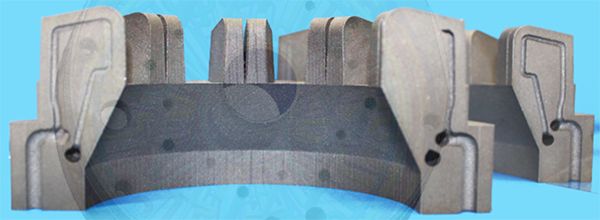Conformal Cooling for Complex Dies

RPM partners with a German company for all conformal cooling projects. The ability to create uniquely shaped forms or complex dies using the process of sintering produces extraordinary cost benefits.
Benefits of Conformal Cooling
- Shortens the production cycle time
- Uses less material
- Improves quality
Conformal Cooling Applications
Conformal cooling is very well suited for producing tooling or parts with complex geometry, to remove heat from areas where traditional tooling methods cannot reach.
Conformal cooling technology is used by the tooling industry to make direct tooling inserts to manufacture parts for a variety of industries including aerospace, dental, medical, packaging and other industries that have small to medium size, highly complex parts.
Given the ability to build multiple parts simultaneously, Conformal cooling technology is very cost and time effective.
Conformal cooling employs direct metal laser sintering (DMLS) technology, which is ideal for rapid prototyping. DMLS decreases development time for new products, and enables production manufacturing as a cost saving method. DMLS can simplify assemblies and the creation of complex die and part shapes.
How Conformal Cooling works
Conformal cooling involves the use of a cooling channel design, based on the product contour required.
By increasing cooling efficiency, the cooling rate difference can be minimised through the whole part, reducing cycle time and cost and increasing product quality.
Direct metal laser sintering (DMLS) is an additive manufacturing technique involved in conformal cooling, which uses a laser as the power source to sinter powdered material, which is normally metal. The laser is automatically aimed at points in space defined by a 3D CAD model, binding the material together to create a solid structure.
In DMLS a technician works with the 3D model in the machine’s software to ensure correct geometric orientation and supports structures. When the build file is complete, it is ‘sliced’ into layers and downloaded to the DMLS machine, which uses a high-powered laser beam to fuse the metal powder into a solid part by melting it. Parts are built layer by layer, which enables the completely automated creation of highly complex die shapes, in just hours, without any tooling.
Direct metal laser sintering (DMLS) has numerous advantages over traditional manufacturing techniques, especially for unusual dies or complicated form shapes.
- Because no special tooling is required, unique parts can be built in a matter of hours
- Direct metal laser sintering makes it possible to design internal features and passages that could not be cast or otherwise machined, because the components are built layer by layer
- Complex geometries and assemblies with multiple components can be simplified to fewer parts with a more cost effective assembly
- Direct metal laser sintering allows for more rigorous testing of prototypes, as since most alloys can be used for DMLS, prototypes can be functional hardware made, constructed in the same material as production components will be made of
Direct metal laser sintering is one of the few additive manufacturing technologies being used in production, and produces parts with high accuracy and detail resolution, good surface quality and excellent mechanical properties.